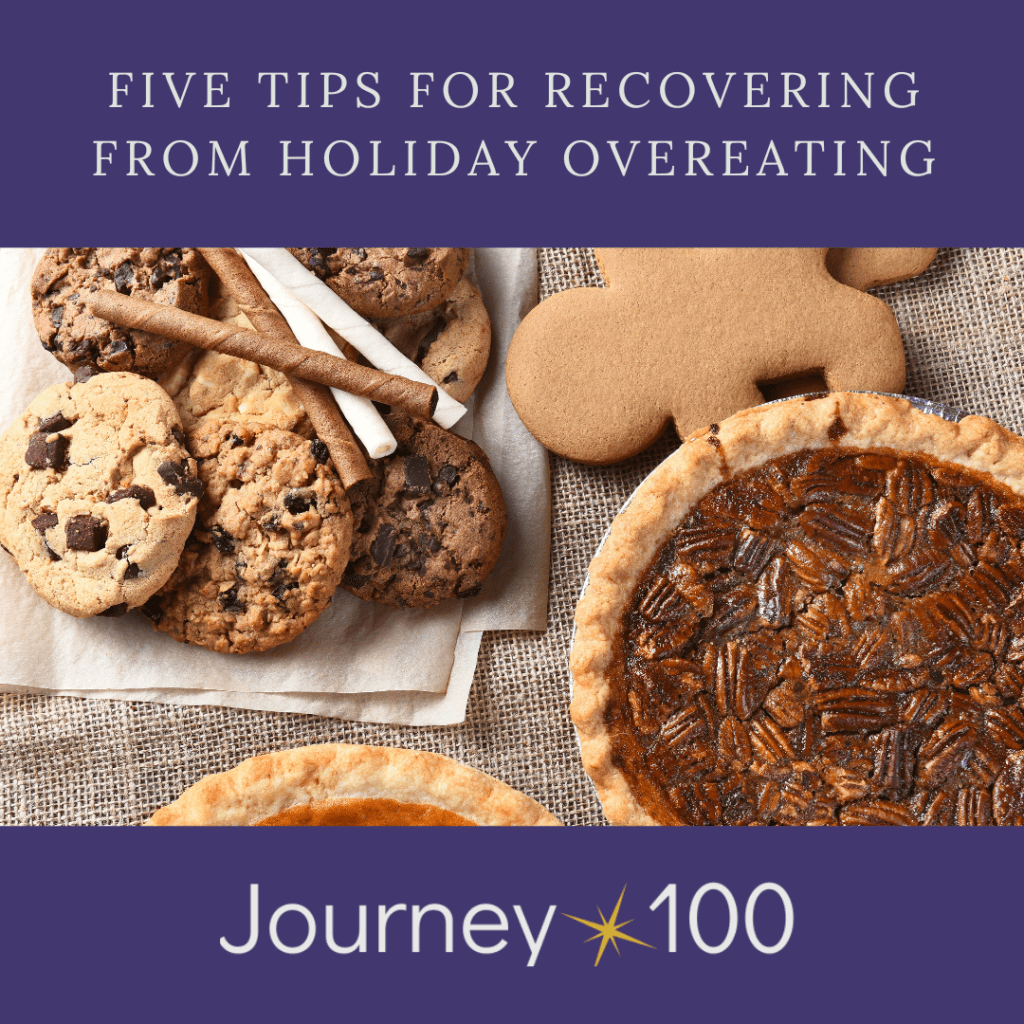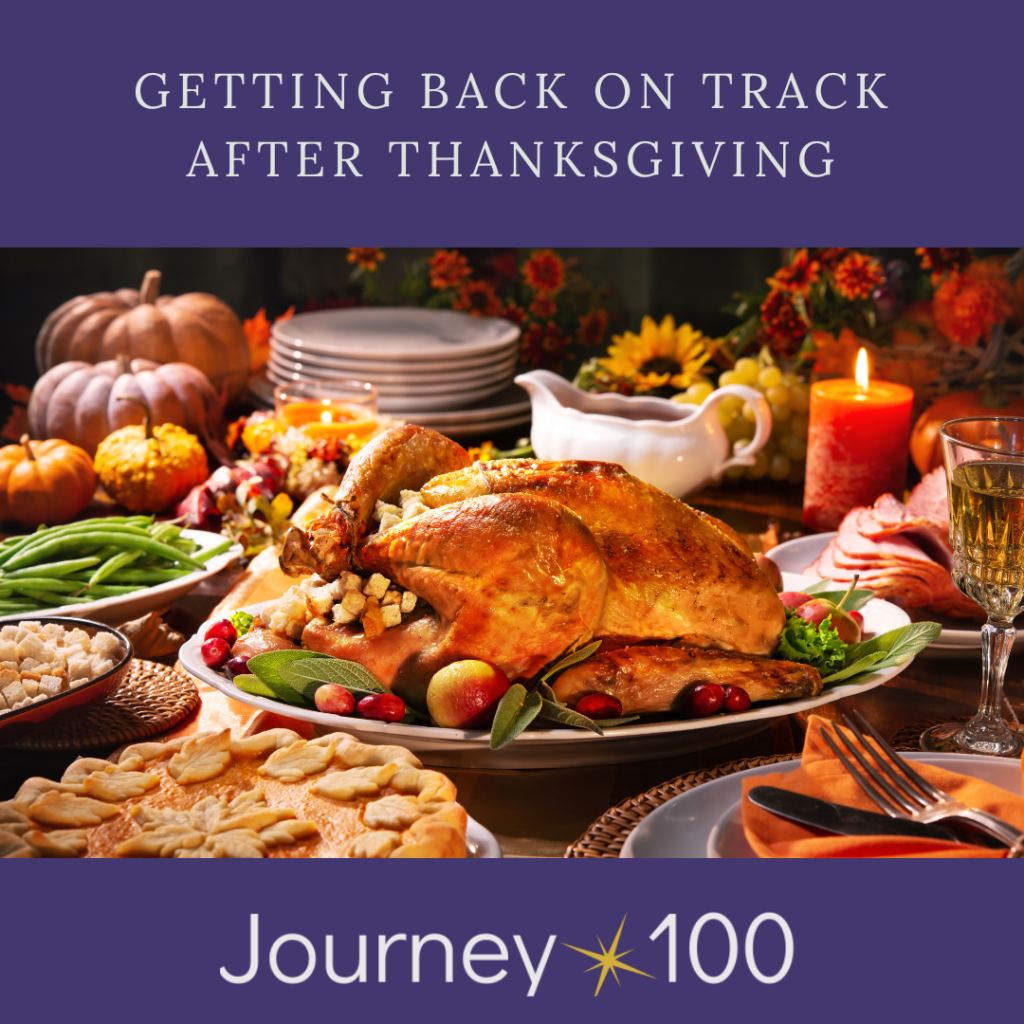Five Tips for Recovering from Holiday Overeating

The holiday season is marked by good times with family and friends plus delicious, holiday treats. If you have been overeating these holiday treats, then these five tips on recovering from holiday overeating are for you! 1. Hydrate, Hydrate, Hydrate: After indulging in holiday goodies, prioritize hydration. Water is your body’s best friend when it comes to flushing out toxins and aiding digestion. If you overindulged in alcoholic drinks then you are likely dehydrated and in need of hydration. Grab your trusty water bottle and make it your sidekick throughout the day. Not only will it help detoxify your system, but it can also curb those lingering sugar cravings. 2. Reconnect with Nutrient-Rich Meals: Reset your system with nutrient-packed meals. Think fresh veggies, lean proteins, and whole grains. These foods provide the essential nutrients your body craves, helping stabilize your energy levels and getting you back on track. I love using this technique as a way to focus on what TO eat rather than restricting other foods. This way you focus on nutrients and naturally crowd out room on your plate for other, less nutritious foods. 3. Move Your Body in a Way You Enjoy: Banish guilt and embrace movement that brings you joy. Whether it’s a brisk walk, a dance session in your living room, or a calming yoga class, find an activity that feels good for you. Physical activity not only burns those extra calories but also boosts your mood, helping you regain that post-holiday feel good vibes. 4. Plan Your Meals and Snacks: Creating a plan can be a game-changer. Outline your meals and snacks for the day to avoid impulsive choices. Planning ahead helps you make mindful and balanced food decisions, ensuring you nourish your body without feeling deprived. 5. Practice Mindful Eating: Savor each bite and be present during meals. I like to practice mindful eating by always sitting at a table to eat, limit conversations and make sure my phone (or TV) are not in sight. Mindful eating allows you to recognize true hunger and fullness cues, preventing overeating. Put away distractions, engage your senses, and relish your food consciously. Remember, we’re all human, and a little indulgence during the holidays is perfectly normal. It’s the actions we take afterward that truly matter. Treat yourself with kindness and use these simple tips to guide you back to feeling your best. Here’s to a healthy and vibrant start to the year ahead! Your Coach, Andrea
How to get back on track after Thanksgiving

The day after Thanksgiving can be a day of regret for those on a weight loss journey. Many of my clients stray from their protocols or have too much to eat. Here’s a simple three step process for getting back on track after Thanksgiving: Calm down Thanksgiving is one single day. Not the end of the world. Whatever happened on Thanksgiving can simply remain in the past and not affect how you show up today. Getting back on track after Thanksgiving is equally an option as continuing to overeat throughout the rest of the holiday season. You’re not a failure, weak willed or doomed to being overweight for the rest of your life. Take a few deep breaths and remind yourself that you are worthy no matter what. Analyze without judgement Next, think about yesterday and which choices you wish you could change. Maybe it would have been only having one plate of food or skipping the piece of pie. Ask yourself what contributed to those choices? Was it wanting to please someone else? Not wanting to say no? Maybe you didn’t want to feel left out? There are no right or wrong answers. It’s just information. Information that helps you better understand yourself. When you understand yourself better, you can make better choices. Then replay yesterday in your mind and envision yourself making better choices. If you need help thinking of how you could have done things differently, check out this post on Weight Loss and the Holidays. Remember getting back on track is an option Finally, remind yourself that even though you might wish things had gone differently, you are still capable of reaching your weight loss goals. Your journey will be full of ups and learning moments. This is your learning moment. You can learn from this and get back on track for your weight loss goal. Then move forward committed to making decisions today that are loving and supportive of your weight loss goals. If taking loving responsibility is difficult for you, I can help. Being able to understand your actions and getting back on track without shaming yourself is what makes the difference between reaching your weight loss goal or spinning in a weight loss/gain cycle for years. Sign up for a call with me to get started today. Your Coach, Andrea
Four steps to help with trigger foods

Trigger foods. Foods you can’t resist. They call out to you and beg you to eat them. Generally, these foods are not carrots, broccoli or apples. They are decadent foods. Often foods that you are forbidden because they are “bad foods” or unhealthy. You probably feel out of control around these foods and blame them for any weight gain. Never fear! If you need help with trigger foods, this post is for you. Here are four step for handling trigger foods like a boss: 1. Quit calling it a trigger food Seems simple right? But every time you call ice cream or chips your trigger food, you give all of your power away to it. It becomes a dramatic story of how this food is the downfall of your weight loss. You are powerless around it and must indulge. Calling it a trigger food puts you and your weight loss at an extreme disadvantage. Many people will tell you that they can’t keep certain foods in the house. And while this is good intentioned that doesn’t mean you will never come face to face with that food. Continuing to have this story in your mind guarantees anxiety, worry, and fearfulness about when you might come face to face with that food. It can also lead to binging on these foods when you finally get the chance because they have become forbidden even though your desire for them is high. Instead of calling them your trigger food, change the story to something more boring, like “It’s just a food you like to eat.” 2. Calm your brain down Our brains have been designed to keep us safe. Back in the times of cavewomen, this meant being able to identify ALL the problems around us that could cause us harm. Life today does not require our brains to find the mountain lion or the poisonous berries. But our brain still wants to do what it was designed to do: FIND ALL THE PROBLEMS. And guess what, your trigger food has been identified as a problem. And that’s OK. Not every problem our brain identifies is a true problem. Nor is every problem our brain identifies a reason to take action. Your brain might tell you things like: “Oh my god, there goes my diet!” “I can never lose weight and have a social life too!” “I will never be able to resist those!” “I can never stop eating….” All of those are just thoughts. Thoughts that are completely optional. Currently those thoughts are full of drama and doom. Calm your brain down by making the story boring. Remember, this isn’t a trigger food. This is just a food I enjoy eating. It can also be helpful to recognize other things you enjoy doing but are able to practice restraint around. I love going for walks on beautiful days but somehow I still manage to go to work and earn a living on beautiful days. I love spending money on cute clothes and yet each month I make sure enough remains in my account to pay the mortgage and utilities. I’m sure you have similar examples in your life. Don’t take what your brain presents you as the truth. Ask yourself if your brain is being dramatic and if you have evidence that the opposite is true as well. 3. Visualize how you want to eat them Now this isn’t a lusty visualization practice. The purpose isn’t to create more desire for the food by imagining how amazing it tastes. This visualization is to practice being around these trigger foods and imagining yourself being in control and intentional about how you eat them. My clients often feel burdened and powerless around these trigger foods. So I ask them to imagine what it would look like to be in control around them. Imagine yourself having your trigger food in your pantry. Visualize yourself going into the pantry for other things and never reaching for that food. Imagine yourself being unaffected that it is sitting there. Another visualization you can do is enjoying the trigger food. Watch yourself plate it, eat half of it and then throwing the rest out. If that causes you some anxiety, remind yourself that you are able to buy more at any time. This food is always available to you. Reminding yourself this can provide comfort that no matter what you are in charge and able to obtain that food whenever you want. It helps take away the scarcity and urgency away from that food. 4. Practice being around them Once you spend time visualizing yourself around these trigger foods, you can practice being around them in real life. Before you do, use that brain for what it was designed for! Ask it what problems might come up that could derail you from showing up as you visualized. Maybe you won’t want to stop eating it. Perhaps you eat the entire box of them. After identifying the potential problems, come up with a game plan. Maybe you start with two cookies on a plate and put the package away. Or you serve some chips and dip and then relocate to another room to enjoy them. Whatever you think might help you stick with your plan that you visualized. Then go for it! Remember, perfection is not a requirement and it is likely that you might have some overeats or completely ignore the plan all together. That’s OK. Progress has already been made by thinking it through beforehand and you’ll get more and more skilled at being around your trigger foods the more you practice. What trigger food will you practice with? Your Coach, Andrea
Weight Loss and the Holidays

Oh, the holidays. So many of us think about this time of the year with all the decadent meals and parties and figure we are better off throwing in the towel and restarting on January 1st. But does it have to be that way? Here’s the reality of November and December: Thanksgiving is 1 meal. Christmas Eve / Christmas Day is 4 meals. New Year’s Eve is 1 meal. Holiday parties between 2-5 meals. Total Holiday meals = 8-11 meals If you start counting from November 20th through the end of the year, there are 42 days. Multiply each of those days by 3 meals and you have 126 meals. Subtract those 8-11 indulgent, celebratory meals and that’s 115 meals to make regular food choices that fuel your body well. That’s 115 meals that can move you forward towards your weight loss goal. Here are five tips for weight loss during the holidays: 1 – Set your mindset and intention for the rest of the year. On January 1st when you look back at the holiday season, how do you want to feel? This is a great place to start is deciding how you want to show up during this time. Maybe you want to feel proud, loved, amazed, joyful or grateful. I teach my clients that our thoughts are what create our feelings which affect the actions we take in life. So start with a thought to carry throughout the holiday season as your mantra. Proud – I’m capable of balancing health, self care and holiday festivities. Loved – I’m surrounded by so many people that I love and that love me however food is not love. Amazed – I am continuing to rock weight loss even during the holiday season! Joyful – I love finding the joyful, non-food moments during this holiday season and cherishing them. Grateful – No matter what the year offered, I am blessed to be here surrounded by love. 2 – Plan for and create desire around your indulgences. This time of the year is well known for decadent foods, endless sweets and merry making by the glass full. So many of us think that these tasty foods are foods that we can only eat once a year….but is that really true? This thought isn’t very dangerous unless you are using it as another excuse to give permission to gorge yourself on it. If you are finding this is the case, simply remind yourself that you are a grown adult that can afford to buy or make whatever you want, whenever you want it. That same thought can be used to create more desire and excitement to savor certain foods. Be mindful that Christmas holds such a place of excitement in our hearts because it only comes once a year. If we had Christmas every day, people would get really tired of the parties, wrapping presents and decking the halls quickly. Instead of eating the sugar cookies morning, noon and night, practice being intentional and waiting a bit to indulge in them. Maybe you have a special date with yourself in the afternoon with a hot cup of coffee and a cookie. Make it special. Make it count. Make it something to really look forward to and savor that moment. Likewise be particular about which indulgence you want to enjoy and when. Not every party needs to mean eating decadent appetizers, desserts and drinking alcohol. Be selective. Christmas Eve with your parents will be the time you enjoy those amazing meatballs but abstain from alcohol. The office work party will be your time to eat your coworkers famous English toffee. The Moms Club Christmas party is when you will toast the night with a glass of wine with your girls. Another great option is to choose certain times when you want to enjoy these items. Maybe you want to only have drinks at one event on weekends only. You could also limit sweets to Tuesday nights with the kids. Then the rest of the time you focus on regular eating to keep your body feeling at its best. 3 – Create a Party Protocol Holiday parties can be a huge hurdle when you are trying to lose weight. Most of the time you don’t know what will be served (except that it will for sure not be calorie free food) and many times the entire group activity is eating, drinking and chatting with each other. So many of us go in hoping we’ll make OK food choices only to leave the party regretting that we didn’t wear stretchy pants. My grandfather had a saying “Put your hopes in one hand, spit in the other and see which one fills up first.” And it’s true! Hoping you make good food choices isn’t helpful. Your brain needs more clear instructions on what to do. So make a party protocol! Here are some ideas that you could incorporate into your own party protocol: Start with a plate of fruits and veggies first. Wait one hour after you arrive before getting an alcoholic or non-water drink. Go around and talk to everyone at the party first before making a plate to eat. Leave empty space on your plate between all foods. Limit yourself to one plate, including any sweets. Alternate between water and alcohol/non-water beverage. Don’t try everything. Ask around what everyone is enjoying and take the top three raved about foods. Try everything. Serve yourself one bite of everything. Only go back for more of your favorite item. Every plate is half fruits or veggies. Don’t let your brain try to tell you that you’re being restrictive. Our brains LOVE to throw a fit when it feels like it’s not getting what it wants. Be ready to talk back to your brain and tell it “I’m choosing to enjoy the party this way. No one is making me do this. I made this plan and I want to see what happens when I follow through.” 4 –
